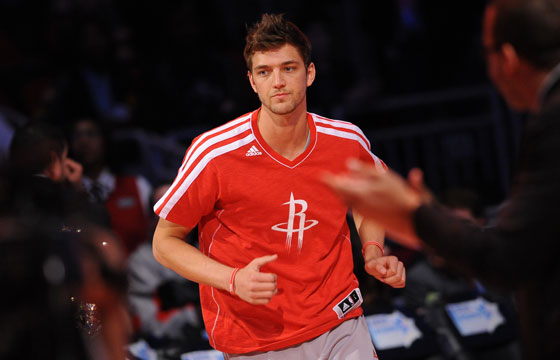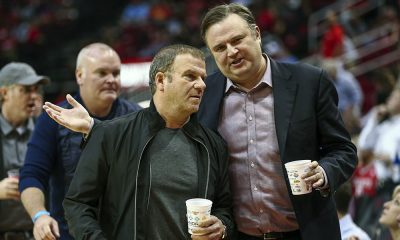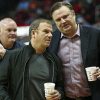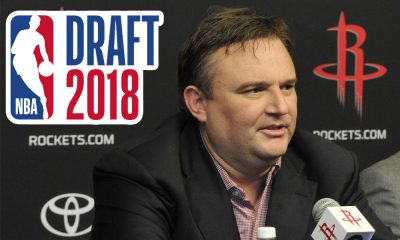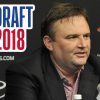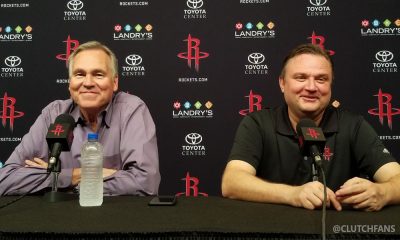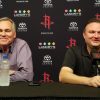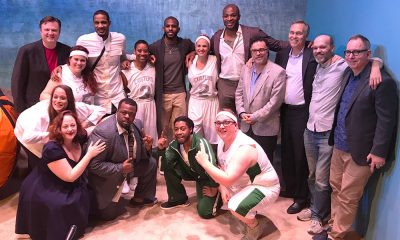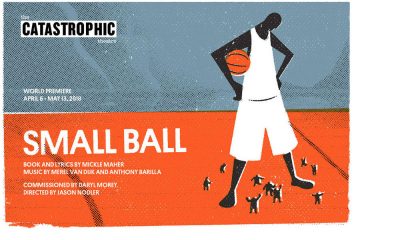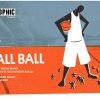Houston Rockets
The Chandler Parsons Contract, Take Two
The current version of this article contains a minor change as of May 30, 2013. Back on December 23, I made my first formal attempt at explaining the intricacies of the NBA player contract of Chandler Parsons. As a mere fan (and not an actual NBA insider or team executive), I based that piece on educated conclusions using the information available to me at the time. Unfortunately, only after putting out my prior article was I made aware of additional information that greatly impacts the overall analysis of Parsons’s contract. Hence, the following is a (more informed) analysis of one of the more interesting player contracts in the NBA today.
Published
13 years agoon
The current version of this article contains a minor change as of May 30, 2013.
Back on December 23, I made my first formal attempt at explaining the intricacies of the NBA player contract of Chandler Parsons. As a mere fan (and not an actual NBA insider or team executive), I based that piece on educated conclusions using the information available to me at the time. Unfortunately, only after putting out my prior article was I made aware of additional information that greatly impacts the overall analysis of Parsons’s contract. Hence, the following is a (more informed) analysis of one of the more interesting player contracts in the NBA today.
Parsons Not Subject to Rookie Scale Salary Rules
The NBA has specific rules governing first round draft picks and the contracts they can sign, commonly referred to as rookie scale contracts. Such contracts are four-year deals, fully guaranteed for the first two years, with team options for each of the third and fourth years (each of which must be exercised almost an entire season in advance) and a right of first refusal after that.
However, Parsons was not a first round pick. He was selected in the second round (the 38th overall selection) of the 2011 NBA Draft. Therefore, he is not subject to such rules. Second round picks can be signed to contracts much like any other player. Unlike first rounders, second rounders do not have any scale salary by which a team may exceed the salary cap to sign them. Most second rounders receive either a one- or a two-year deal at the league minimum salary. Such contracts are oftentimes non- or only partially guaranteed. The only ways in which a team may sign a second round pick to anything more are for that team to have either cap room or a salary cap exception (such as the Mid-Level Exception) at its disposal.
The Contract Structure
In December 2011, the Rockets signed Parsons to a four-year, $3,629,500 contract (using a sliver of remaining salary cap room they had at the time). Like the contracts previously given to Jermaine Taylor and Chase Budinger, Parsons agreed to bind himself to the team for four years in exchange for an increased salary in the first year ($850,000 instead of the league minimum of $473,604) and second year ($888,250 instead of the league minimum $762,195), both of which are fully guaranteed.
However, Parsons seems to have had a better agent than either Taylor or Budinger.
Whereas Taylor and Budinger agreed to give the Rockets fully non-guaranteed Years 3 and 4 (together with a team option on Year 4), Parsons and his agent negotiated for additional financial security. By Parsons having not been waived by the Rockets before January 1, 2013, Parsons’s salary for the 2013-14 season ($926,500) became partially guaranteed for $600,000; and if Parsons is not waived by June 30, 2013, his 2013-14 salary becomes fully guaranteed. Furthermore, if the Rockets do not waive Parsons by January 1, 2014, his salary for the 2014-15 season ($964,750) becomes partially guaranteed for $624,771 (the same percentage partial guarantee as in Year 3); and if Parsons is not waived by June 30, 2014, his 2014-15 salary becomes fully guaranteed.
The key bit of new information relating to the Parsons contract?
It also has a team option on Year 4.
This means that, despite having already guaranteed Parsons $624,771 for the 2014-15 season, the Rockets have the right to decline their team option, essentially “eat” that money, and make Parsons a restricted free agent. If the Rockets instead exercise that team option, then when his contract expires in 2015, Parsons will be an unrestricted free agent.
What Happens Next?
1. Parsons is “stuck” on this contract until at least 2014.
The Parsons Contract was negotiated at a time when it was not certain whether he would become a legit NBA player. At that time, this deal was quite a coup for both Parsons and his representatives. Now, however, with Parsons playing at a very high level, the contract may seem like a long-term (financial) prison sentence.
First off, there is little incentive for the Rockets to let Parsons out of his dirt-cheap deal. They have him locked up on a very favorable deal for this year and two more after that. For a team trying to manage its cap situation in order to add a second (or even third) star player, giving Parsons a raise before his contract is up in 2015 might jeopardize those plans.
And even if the Rockets wanted to give Parsons a raise before 2015, there really is no feasible way to do that without risking his departure to another team (with the possible exception of a renegotiation-and-extension, discussed below).
Since only Year 4 of Parsons’s deal is a team option (as per CBA rules, contracts can only contain one option year), there is no way to make Parsons a free agent before 2014 without waiving him. Unfortunately for the Rockets, Parsons is such a good player that there is no way he would clear waivers — other teams would be climbing over each other to get a chance to claim him off waivers. So, unless the Rockets want to give Chandler away to another team without receiving anything in exchange, they need to simply hold onto him on his current deal. At least through next season.
Rockets GM Daryl Morey even brings up — perhaps against his better judgment — that Parsons approached the team about restructuring his contract. See Zach Lowe’s interview with Morey here, and skip to the 16:40 mark.
2. An extension of Parsons’s contract is not a viable alternative.
Because Parsons is a veteran on a four-year deal (other than a first round draft pick on a rookie scale contract), he is technically eligible for an extension from the Rockets in 2014. Many fans have suggested that the Rockets give Parsons an extension in order to give him a substantial raise and keep him under contract beyond 2015. However, the rules governing contract extensions do not make this a financially feasible option for Parsons.
Under the CBA, a player may not receive an extension giving him a raise in excess of 107.5% of his salary in the last season of the contract being extended. For Parsons, an extension would cap his 2015-16 salary at $1,037,106. I’m guessing that Parsons (and his agent) feels that he can do better than that on the open market.
So, go ahead and cross the contract extension route off the list of possibilities, unless . . .
3. A contract renegotiation remains a possibility but is not in the team’s best interests.
While a contract extension is not economically feasible for Parsons, there remains the possibility of a contract renegotiation with a simultaneous extension. Only teams that are under the salary cap can renegotiate player contracts. For instance, the Oklahoma City Thunder implemented this “renegotiate-and-extend” approach with Nick Collison in 2010 (you can read more about that deal here). While the 2011 CBA changed the rules about these deals to limit the decrease in salary a player could accept in the first year of his extension to 40% (making Collison’s particular contract impossible to do now), the Rockets could still position themselves to keep Parsons locked up via a simultaneous renegotiation and extension.
However, this approach would seriously hamper the Rockets’ overall rebuilding strategy.
First of all, the Rockets would need to be under the cap during the 2014-15 season for this to even be possible. That would mean that the team likely failed in its attempts to acquire a second star player between now and then. It also means that the team did not even use its cap room during the summer of 2014 or at the February 2014 trade deadline to otherwise improve the team beyond 2014. Unless Parsons has developed into a bona fide perenniel All-Star caliber player by that time, there is little incentive to jeopardize the team’s cap situation — and its continued pursuit of that second star player — for the sake of locking up a good (but not great) player.
Also, even with a Collison-like contract in place, Parsons would have a relatively substantial cap figure locked in on the Rockets’ roster entering the summer of 2015, when the contracts of Jeremy Lin and Omer Asik are set to come off the books and the Rockets possibly positioned to add another significant piece to the puzzle.
4. Letting Parsons hit restricted free agency is risky but may be how team does right by him.
The renegotiation-and-extension route assumes that the Rockets do, in fact, pick up their team option on Parsons. However, if the Rockets (1) didn’t have the requisite cap room available to accomplish a renegotiate-and-extend deal, (2) felt that they could potentially lock up Parsons longer-term at a more reasonable cost through restricted free agency than if he hits unrestricted free agency in 2015 and/or (3) feared that Parsons would hold a grudge against the team if it kept him on his dirt-cheap deal for a fourth season, then they might opt to decline Parsons’s team option and allow him to hit restricted free agency in 2014.
Because Parsons would have been under the same contract with the Rockets for three seasons (2011-2014), the Rockets would have full Bird rights on Parsons and could exceed the salary cap to re-sign him to a five-year deal at any amount (up to a “James Harden-level” max contract). Presumably, this option would only be explored if the team had already used up most of its cap space to add a second star player or other significant pieces.
Making Parsons a restricted free agent would likely be a huge show of good faith on the Rockets’ part, but it would not be without great risk. Many of us remember what happened to the Cleveland Cavaliers back in 2004. The Cavs decided to do Carlos Boozer a solid and decline their cheap team option in order to make Boozer a restricted free agent, looking to lock him up long-term. Unfortunately, once Boozer became a free agent, the Utah Jazz swooped in with a huge contract offer. Boozer bolted Cleveland for greener pastures, and the Cavs were left holding the bag.
Also, from a pure numbers standpoint, it is unlikely that the Rockets could save enough money over the course of a new deal with Parsons signed in 2014 — either with Houston or in an offer sheet with another team — versus one he signs as an unrestricted free agent in 2015 to justify foregoing the opportunity to keep Parsons at his currently-scheduled $964,750 salary for 2014-15. Remember, if the Rockets decline their team option, Parsons would still pocket $624,771 from Houston (which would count against the cap) on top of whatever he could get in free agency.
However, if the Rockets are confident that Parsons would work with them on a reasonable long-term deal without bolting as a free agent, their show of good faith may be reciprocated, to everyone’s advantage.
5. Letting Parsons hit free agency in 2015 may best help the Rockets’ cap situation.
Notwithstanding the potential benefits above of taking care of Parsons in 2014, the fact that the Rockets (even with the addition of another significant piece in the next three years) might possibly have substantial salary cap room in 2015 means that there may be much to be gained by exercising that team option, keeping Parsons on his contract for a fourth season, and letting him hit unrestricted free agency in 2015.
Because of Parsons’s miniscule 2014-15 salary, his cap hold on the Rockets’ books when he hits free agency until he is signed (either by the Rockets or another team) will be a paltry $1,833,025.
This means that the Rockets could use all of its available cap room in 2015 — except for that $1,833,025 cap hold amount — to pursue a major free agent (such as Kevin Love, who can opt out of his contract with the Minnesota Timberwolves that summer), then later exceed the salary cap to re-sign Parsons to any amount using his Bird rights.
Admittedly, this approach will involve asking Parsons and his representatives to trust in the organization to do right by Parsons once the dust settles on the team’s other summer plans. This may be a tough task, given that the team will have already foregone the chance to do right by Parsons in 2014 by picking up its option on the fourth season. Parsons’s agent will certainly market his client around the league to gauge his “fair value” as a free agent, so numbers would likely be discussed while other plans play out.
Conclusion
Barring a trade, the Houston Rockets and Chandler Parsons are stuck with each other under his current contract until at least 2014. An apparent victory for the player at the time of its original execution, the contract is now one of the most team-friendly in the entire league. The Rockets have Parsons locked up until 2015 for a mere pittance. They also have the option to either make Parsons a restricted free agent in 2014 or keep him around for a fourth cheap year and let him hit unrestricted free agency in 2015. Parsons’s low salary (and his cap hold in the summer of 2015) will position the Rockets nicely to continue to add significant pieces over the next several years.
>> Comments
Analysis
Podcast: As trade season begins, will the Rockets make a splash?
Published
2 weeks agoon
December 16, 2025By
Ben DuBose
In this roundtable conversation, ClutchFans Editor Dave Hardisty joins Ben DuBose and Paulo Alves to preview the NBA’s upcoming transaction window and its potential implications for the 16-7 Houston Rockets.
December 15 is when players who signed contracts in the preceding offseason become trade eligible, so the period from Monday until the in-season deadline of February 5, 2026, is likely to be among the most active on the 2025-26 calendar.
Discussion topics include roster needs and potential trade targets across the board, including the likelihood of bigger-name deals (such as Giannis Antetokounmpo, Jrue Holiday, and James Harden) and smaller acquisitions along the lines of Keon Ellis, Chris Paul, and Ayo Dosunmu.
The show also explores Houston’s potential desirability on the buyout market and the team’s long-term timeline for title contention, and specifically why those factors might make this a relatively quiet trade window for the Rockets.
Editor’s note: Hardisty and DuBose also host regular “ClutchFans Live” postgame recap shows on YouTube, while DuBose and Alves are co-hosts of the Rockets LaunchPod podcast, presented by ClutchFans and with support from SportsTalk 790 — official flagship radio station of the Rockets. Tune in to both shows for more coverage!
Analysis
NBA front-offices poll: Rafael Stone’s Rockets rise to No. 3
Published
2 weeks agoon
December 10, 2025By
Ben DuBose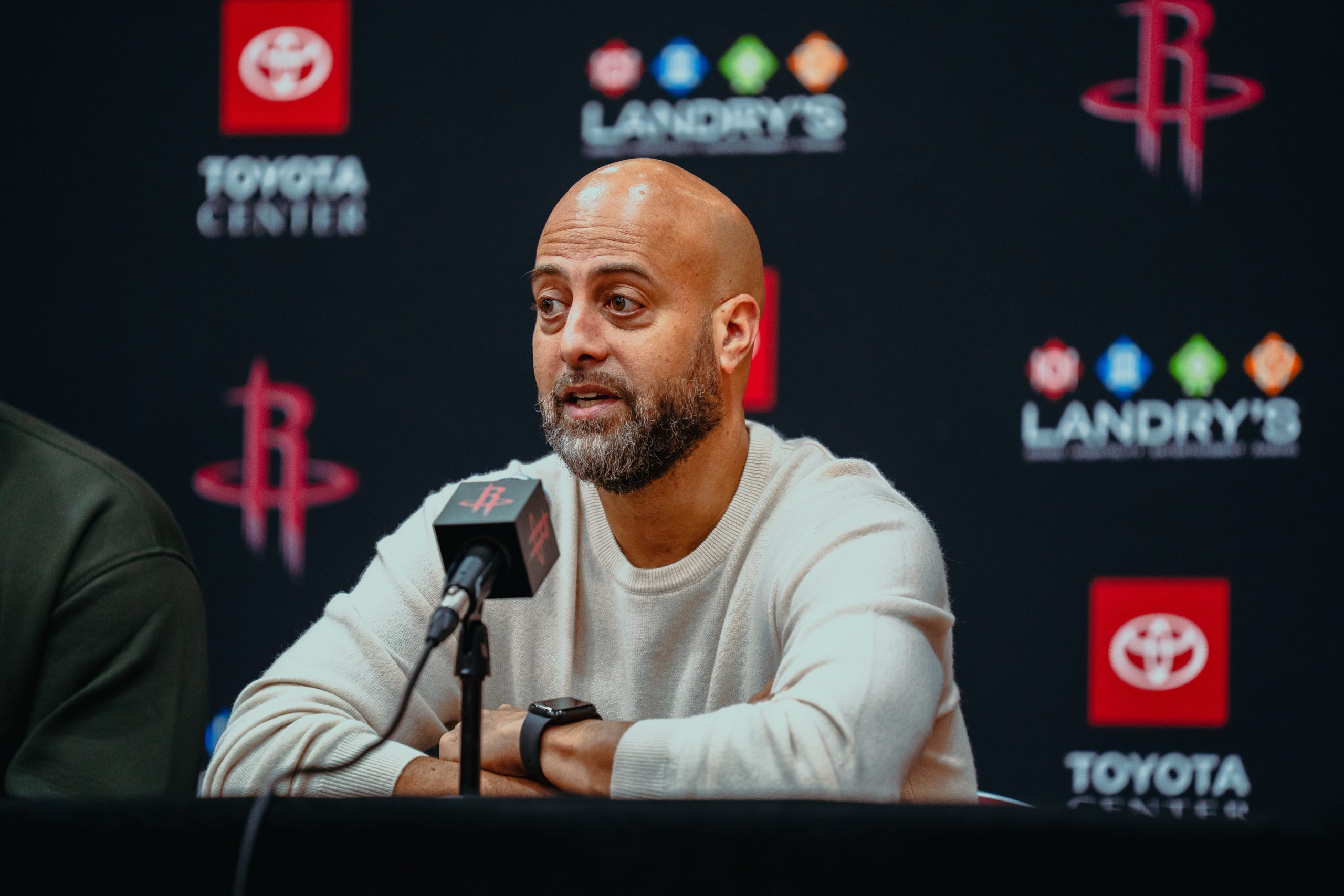
At 15-6, the Rockets are currently tied for the second-fewest losses in the Western Conference standings, and they own the NBA’s No. 2 net rating.
And yet, just two years ago, Houston was coming off three straight rebuilding seasons with the worst record in the West.
It’s been a remarkable rise under the guidance of general manager Rafael Stone, who has combined the development of young players such as Alperen Sengun, Amen Thompson, Jabari Smith Jr., and Reed Sheppard with the acquisition of impact veterans — namely, Kevin Durant, Steven Adams, and the injured Fred VanVleet.
Making matters even better, the Rockets added and developed all that talent while still retaining several high-end future draft assets, to boot. Houston believes that draft equity can make it a sustainable contender for years to come, both in terms of having desirable trade assets and an ability to replenish its roster depth in cost-efficient ways.
With the 2025-26 regular season now at approximately its quarter pole, The Athletic recently canvassed 36 executives across the league — presidents, general managers, vice presidents, and assistant GMs — to rank the NBA’s top front offices.
Led by Stone, the Rockets’ front office comes in at No. 3, trailing only the last two champions — the Oklahoma City Thunder and Boston Celtics.
“High-end talent, a willingness to be bold, (and) good asset management,” one executive told The Athletic, when asked to sum up the Rockets.
Time for our annual crowdsourcing to determine the NBA's top front offices – ranked by the NBA's front offices. We found 36 team executives to give us their picks of the best ones right now, and their pick of one FO that is up and coming. In @TheAthletic:https://t.co/9QRrkK8R0b
— David Aldridge (@davidaldridgedc) December 10, 2025
Houston finished with one first-place vote; six second- and third-place votes, apiece; five fourth-place votes; and three fifth-place votes.
“They have drafted well, built a deep team in a tough Western Conference while managing tax aprons,” said one executive who voted the Rockets second. “(They) hired a good coach (Ime Udoka) and built an overall team identity, then added KD for cheap. From where they were only a few years ago, they have done a good job turning it around.”
Per Sam Amick of The Athletic, Stone “values this young core greatly and has frequently resisted the temptation to reach for overpriced roster shortcuts.” Udoka has an “influential voice” with the front office, as well, Amick adds.
Amick notes that the Durant trade came at a relatively low asset cost, adding that the Rockets are uninterested in pursuing a trade with the Memphis Grizzlies for disgruntled star Ja Morant.
The Athletic’s complete front-office rankings can be viewed here. This time a year ago, in the same exercise, Houston finished in a tie for the No. 11 spot.
Analysis
With NBA Cup run complete, Rockets add Clippers, Nuggets to December schedule
Published
4 weeks agoon
November 29, 2025By
Ben DuBose
After their Emirates NBA Cup 2025 elimination, the Rockets (12-4) learned two additional December dates for their 2025-26 regular season.
As announced Saturday by the league office, the Los Angeles Clippers (5-14) will visit Houston on Thursday, Dec. 11. Tipoff at Toyota Center will be at 7:00 p.m. Central.
Meanwhile, the Rockets (12-4) will then head to Denver on Monday, Dec. 15, where tipoff versus the Nuggets (13-5) is at 8:30 p.m. Central.
During Cup games, all three of the Clippers, Nuggets, and Rockets went 2-2 in Western Conference group-stage play. Because only four teams out of the 15 in each conference advance to the knockout rounds, a 2-2 record in group games isn’t usually enough to finish among the top four, and that was again the case this year.
To ensure that all teams play 82 regular-season games, teams who don’t advance then have two additional December games scheduled versus same-conference opponents who also did not advance.
In most cases, these add-on matchups come down to a formula. Taking Houston as an example, each season’s schedule includes two games (one home, one away) versus all East opponents and four games (two home, two away) versus most West opponents.
However, if that was the case for all same-conference opponents, the schedule would be at 86 games in length. So, there is a select group — rotating each year — of same-conference opponents on the docket only three times.
To trim down to 80 games (to account for the possibility of Cup advancement), the six West teams with only three dates on Houston’s initial 2025-26 schedule were the Clippers, Nuggets, Warriors, Oklahoma City Thunder, Minnesota Timberwolves, and Los Angeles Lakers.
Add-on games are typically chosen from that group, and the Thunder and Lakers advanced in Cup play, thus taking them off the table. So, it came down to two teams from the other four.
Led by James Harden, the reeling Clippers have yet to play Houston this season, though they will meet again on Dec. 23 in Los Angeles.
Meanwhile, the Nikola Jokic-led Nuggets enjoyed a close Nov. 21 victory in Houston. For the Rockets, Kevin Durant and Alperen Sengun each struggled in that game.
Now, less than a month later — in a matchup that could prove pivotal in the West standings race — Durant and Sengun (assuming health) will get an opportunity to make amends.
Denver and Houston are currently tied for the No. 3 spot in the West (trailing the Thunder and Lakers), though the Rockets are technically ahead by percentage points due to playing two fewer games. Thus, that Dec. 15 rematch could have significant stakes for both sides.
Analysis
This Thanksgiving, the Rockets are thankful for Reed Sheppard
Published
1 month agoon
November 27, 2025By
Ben DuBose
Relative to their expected formula from the 2025 offseason, the Rockets were missing five rotation players in Wednesday’s Thanksgiving Eve playoff rematch versus the Warriors.
Kevin Durant (personal reasons), Steven Adams (right ankle tendinopathy), and Tari Eason (right oblique strain) were all sidelined, and veterans Fred VanVleet (right knee) and Dorian Finney-Smith (left ankle) remain on the shelf after offseason surgeries.
Yet, the Rockets (12-4) still won for a 12th time in 14 games, and they overcame a 14-point road deficit against a high-profile Golden State squad featuring the likes of Steph Curry, Jimmy Butler, and Draymond Green.
The biggest reason was second-year guard Reed Sheppard, who set career-highs in points (31) and rebounds (9) while making 12-of-25 shots (48.0%), including four 3-pointers.
“He was big,” said head coach Ime Udoka, whose Rockets won despite shooting below 40% overall and 30% from 3-point range. “Reed really held us together when guys were struggling.”
For the season, Sheppard — a starter for Udoka over the past two games — is averaging 14.3 points, 3.3 assists, 2.8 rebounds, and 1.6 steals in 24.9 minutes per game. He’s shooting 48.8% overall and 45.5% on 3-pointers, with the latter figure coming in at No. 11 among hundreds of qualified NBA players.
But the advanced metrics are even more impressive. Per Basketball Reference, here’s where Sheppard ranks among his NBA peers in several impact categories:
• Box plus/minus (BPM): No. 5 (7.3)
• Defensive BPM: No. 6 (2.7)
• Offensive BPM: No. 15 (4.6)
• Win shares per 48 minutes: No. 10 (.208)
• Value over replacement player (VORP): No. 16 (0.9)
• True shooting (TS): No. 42 (62.9%)
• Player efficiency rating (PER): No. 40 (19.6)
• Steal percentage: No. 5 (3.3%)
The only players with a superior BPM are a quartet of annual Most Valuable Player (MVP) frontrunners in Nikola Jokic, Shai Gilgeous-Alexander, Giannis Antetokounmpo, and Luka Doncic. At the moment, Sheppard is the league’s highest-rated American player!
To say the least, those are remarkable efficiency metrics for a 21-year-old in his second NBA season. And it’s not as if Sheppard is posting those in low-leverage minutes, as evidenced by the key plays he made in the fourth quarter to help put the Warriors away.
“Defensively is where he’s shown the most improvement, overall,” Udoka said from San Francisco. “I think he’s taking on the challenge. The blow-bys are getting less and less. He’s catching up with the physicality of the game. Teams are going to try to attack him, at times, but like we said last year and during this summer, make them go east and west and stay in front of them. Help will come. He’s doing a great job of that.”
Sixteen games in, it’s no longer a particularly small sample. Rounding, it’s actually 20% of the 82-game regular season!
Assuming relative health, the 2025-26 Rockets had a high floor entering the season due to the All-Star presence of Durant and Alperen Sengun. But whether they could achieve a championship ceiling likely depended on further leaps from young players — most notably, the high-upside ones like Sheppard and Amen Thompson.
With Durant out, Thompson was the headliner in Monday’s road victory in Phoenix, and Sheppard stole the show two nights later at Golden State.
For everyone surrounding the organization, it’s an appropriate time to be thankful. With these leaps being shown from players who are extremely young and still improving, the Rockets appear set up to be a force in the Western Conference for quite some time.
“It’s going to be exciting when we get fully healthy and whole,” Udoka surmised.
Analysis
2025 NBA Cup math, schedule update: Rockets unlikely to advance
Published
1 month agoon
November 23, 2025By
Ben DuBose
Entering Thanksgiving week, all 30 teams have at least one of their four group-stage games remaining in Emirates NBA Cup 2025 action. Some have two.
But for the Houston Rockets (10-4 on the 2025-26 regular season, 1-2 in Cup play), elimination appears almost inevitable after Friday’s group-stage loss to the Denver Nuggets.
To explain why, let’s look at the Cup standings entering the week:
After their winning their group in the 2024 NBA Cup, the Rockets have already lost the possibility of doing so in 2025. Even if the Rockets win their group-stage finale at Golden State on Wednesday night, Houston’s best-case outcome is a 2-2 mark.
The only way 2-2 would be tied for the Group C lead is if Portland loses at home to San Antonio on Wednesday, followed by the Spurs winning at Denver two nights later. Without that combination of results, at least one of the Trail Blazers and Nuggets would have three group-stage wins, which inherently eliminates Houston.
But even if that unlikely 2-2 scenario somehow played out, the Rockets would be 1-2 against the other three teams in that 2-2 tie. The Spurs and Nuggets would each be 2-1, thus eliminating Houston as a potential group winner.
So, Group C is off the table.
Mathematically, the Rockets do remain alive for the wild-card slot, which goes to the top second-place finisher in each conference. For example, if this week’s games go according to the Vegas odds, it’s quite possible that the Spurs could defeat Portland but lose to Denver, creating a three-way tie between the Rockets, Trail Blazers, and Spurs at 2-2. Since each team would be 1-1 against the other two, head-to-head, it would come down to point differential — and Houston is well ahead of Portland (-18) and currently tied with San Antonio (+10) there.
Should Houston win that tiebreaker, the Rockets would finish second in in Group C. But looking at the remainder of the West, it’s unlikely for that to be enough to earn the wild card.
For starters, if any second-place team in Group A or Group B gets to three wins, the Rockets are automatically eliminated. Last season, both wild-card teams went 3-1 in group play.
But even if 2-2 somehow becomes enough for a tie, the point differential of the Minnesota Timberwolves (2-1, +53) and Oklahoma City Thunder (2-0, +63) will be difficult to overcome. At the moment, those teams — who play each other on Wednesday — are 43 and 53 points ahead of the Rockets, respectively.
So, in order for Houston’s 2-2 mark to somehow be enough to advance, the Rockets would need to make up at least 43 combined points between the final margin of their road game against the Warriors and the remaining group games for the Timberwolves and Thunder.
To say the least, that’s a tall order.
As a result, while not mathematically eliminated just yet, the odds are overwhelmingly against the Rockets advancing to the eight-team knockout phase.
There could, however, be some consolation. Should the Rockets improbably advance to the knockout rounds as a wild card, they would play on the road in the quarterfinal round. From there, should they win, their next game would be in Las Vegas for a neutral-site semifinal.
On the other hand, if the Rockets are eliminated, they would have two games added to their schedule versus West rivals who they are currently slated to play only three times (and not the usual four for most same-conference teams). These add-on games, which would be played during the week of Dec. 9-16, allow all teams to finish at 82 regular-season games in the final 2025-26 standings — i.e. the same as those who gain additional games from advancing to the knockout rounds. The Cup title game does not count toward regular-season standings.
For the Rockets, in contrast to the wild-card scenario, it’s worth noting that one of those two add-on games would be at home, inside Toyota Center.
The possible opponent pool consists of the Thunder, Warriors, Nuggets, Timberwolves, Los Angeles Lakers, and Los Angeles Clippers — and since these would be non-Cup matchups, it would have to be opponents who were also eliminated in group-stage play.
Breaking down that group of six, the home matchup would likely come against a team that is currently on the books for only one appearance in Houston this season. Based on the current schedule, that’s the Warriors, Nuggets, and Thunder.
Conversely, the other three teams — the Lakers, Clippers, and Timberwolves — are only scheduled to get one visit from Houston this season. So, those would likely be the three in the mix for Houston’s add-on road game.
Since the Warriors are almost certain to be eliminated after the Cup’s group stage — and the Nuggets and Thunder are likely to advance to the knockout rounds — the odds would suggest that Golden State becomes Houston’s additional home game in December.
For the add-on road game, the Timberwolves and the loser of Tuesday’s Lakers-Clippers Cup showdown — both Los Angeles teams are 2-0 in Group B, at the moment — would seem to be the strongest candidates.
So, relative to advancing in Cup play, being eliminated would give the Rockets one additional home game. Furthermore, if the add-on games become the Warriors and Clippers, both of those teams are currently at .500 or below this season. As a result, it’s probably to Houston’s scheduling interest for the Clippers to lose on Tuesday night, though it could be argued that the looming return of Kawhi Leonard makes them more of a threat.
Conversely, should Houston somehow advance, any knockout-round opponent would likely be a stronger team. After all, there’s probably a good reason why that team advanced.
It’s a small silver lining, but it’s not nothing. By not advancing in Cup play, the Rockets are likely to get one more home game at Toyota Center — and it’s likely to be a fun one versus Steph Curry, Draymond Green, and the hated Warriors.
For the Rockets and other teams across the league, those Dec. 9-16 matchups, dates, and times will be announced after the Nov. 28 conclusion of all group-stage games (schedule).

